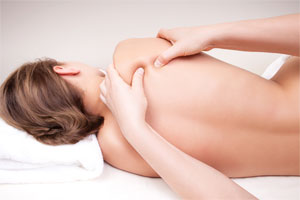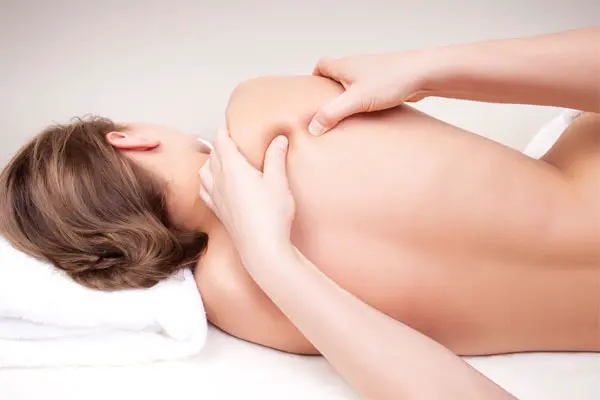There are many different types of alternative treatments for fibromyalgia, but their ability to help relieve widespread pain can be limiting.
Many of these therapies only target specific areas of the body, such as muscle pain in shoulders, thighs, back of the head, the neck or chest.
Tight, painful muscles usually have myofascial trigger points that cause knotted muscles, along with pain, and spread pain to other areas of the body.
What are Trigger Points?
Trigger points are areas on the body that are extremely sensitive and when they are touched, they can cause pain that spreads, restrict movements and they can increase stiffness in muscles.
These knotted areas are usually caused by exertion, stress, poor posture or illnesses like fibromyalgia. If they are not treated, trigger points can spread and form satellite trigger points, spreading pain throughout the body.
There are two types of trigger points, active trigger points, and latent trigger points. Active trigger points cause pain when they are touched and latent trigger points also cause pain when they are touched, but they can cause pain in other areas of the body.
What is Trigger Point Therapy?
This therapy, which is also called myotherapy, is often thought of as a form of massage therapy as it usually uses touch to eliminate trigger points.
It may be practiced by massage therapists, chiropractors, osteopathic doctors or some medical doctors to relieve pain and help provide better muscle flexibility.
During a therapy session, the practitioner may use fingers, elbows or knuckles to exert pressure on a trigger point.
The pressure is applied for 10 seconds and released. The pressure is then reapplied in a pumping motion for another 30 seconds. This helps to elongate muscles and stretch them to help make the muscles more flexible.
Trigger point therapy works by increasing blood flow to the areas where the trigger points are located. Better blood flow allows oxygen and essential nutrients to heal the muscles at the trigger point site.
It also works to release endorphins, which is a hormone that helps to naturally reduce pain. However, touch isn’t the only form of trigger point therapy.
Forms of Trigger Point Therapy
There are both hands-on forms of trigger point therapy and those that use medications and other forms of therapy to help reduce pain at trigger points.
Aside from massage, which is what is described above, there is neuro-muscular adjustment and acupuncture.
A neuro-muscular adjustment involves gentle manipulation of the spine and the small muscles that run along the joints of the spine to help offer relief for lower back pain and headaches.
It is believed those small muscles could be involved in the development of some trigger points.
Using acupuncture for fibromyalgia has had mixed results, but this form of trigger point therapy can help reduce both pain and fatigue.
Research has shown that using acupuncture with a cupping technique has been the most successful type of acupuncture for fibromyalgia patients.
Using Medications to Help with Trigger Points
Other forms of trigger point therapy use drugs to help relieve pain and reduce fatigue in some patients. Trigger point injections use a needle filled with an anesthetic, such as lidocaine or corticosteroid, which is inserted into the center of the trigger point.
The injections work because the pain is eliminated because the body can no longer process it. This forces the knotted area to relax and helps to reduce pain.
Injections can be done on several trigger points during a single visit to your doctor’s office. The injections should be followed up with gentle massage of each area and cold packs can be applied to help reduce any pain.
Injections should only be used for trigger points that cannot be worked out in other ways.
Stretching with heat and/or cooling agents can help relax muscles so that trigger points are released in a gentle manner. Stretching without using heat or cold elements can cause trigger points to recoil and produce other trigger points.
Applying heat helps relax the muscles so they can be stretched and cooling ointments or gels work like an anesthetic to help stretch muscles as well.
Lidoderm patches can be applied to painful trigger points to help reduce pain. These patches contain about 5% lidocaine and should be applied for about four days.
This will help reduce pain for most fibromyalgia patients. There are other topicals that can be applied to try to soothe sore muscles as well.
Using Exercise on Trigger Points
Instead of using massage techniques to help reduce pain and release trigger points, some people opt to use exercise to help unknot muscles.
Gentle stretching is one of the primary exercises that can work out trigger points. By applying gentle pressure while stretching, trigger points can be isolated and the knotted areas on your body relaxed. The pressure can be applied without stretching as well.
Some of the tools that can be used to apply gentle pressure to knots include foam rollers, massage sticks, trigger point balls, a trigger point roller or you can use something as simple as golf or tennis balls.
Using pressure on trigger points works because the pressure lightly stretches the muscles, disrupts the activation of trigger points and allows the muscle to return to a resting state. If done correctly, stretching will feel like a deep tissue massage.
When you do trigger point exercises, you need to keep the pressure on the trigger points throughout the massaging exercises. If it hurts or is uncomfortable, don’t let up on it, but keep massaging the area.
Try to spend time on each sore spot that you find as it will help loosen up and stretch the muscles out and help release the trigger point.
Before you start any trigger point therapies, including exercise, speak with your doctor. They can guide you toward the right therapy to help you reduce your fibromyalgia pain and increase your energy. Stay on any medications for pain until your doctor determines if they can be reduced.
References:
http://www.fmnetnews.com/fibro-basics/treatment/non-drug-therapies
http://www.coreperformance.com/knowledge/training/trigger-point-movements-101.html

